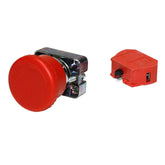Choosing the Right Motor and Drive System for Your Hangar Door
Selecting the correct motor and drive system is fundamental to ensuring that your aircraft hangar door operates smoothly, safely, and reliably over long service cycles. The right pairing provides consistent torque, minimal maintenance, and robust performance under high usage and heavy-load conditions. At Hangar Door Parts, we understand that each project presents unique demands, whether dealing with rolling, sliding, or bi-fold doors. This guide walks through key considerations when choosing a motor and drive system to optimize performance, durability, and energy efficiency.
1. Assess Door Size, Configuration & Load Requirements
Every hangar door presents a distinct set of parameters:
-
Door Weight & Dimensions: Larger doors require higher horsepower and torque to perform consistently. A 2 HP, 3-phase electric motor is often ideal for heavy rolling or bi‑fold doors, especially in bi-fold or high-cycle applications.
-
Door Type & Movement: Rolling door systems may use steel wheel or rubber tire drive systems, while bifold or hydraulic systems rely on operators coordinated with cable or strap mechanisms.
Proper matching of motor speed (RPM), voltage, and drive type ensures smooth acceleration and deceleration, accurate positioning, and long-term durability.

2. Drive System Options: Steel Wheel vs. Rubber Tire vs. Chain Drive
-
Steel Wheel Driven Operators: These systems employ steel wheels mounted on the motor shaft that run on the door track. They are exceptionally durable, require minimal maintenance, and handle high loads exceptionally well. Their uniform contact and limited wear make them ideal for heavy-use environments.
-
Rubber Tire Driven Operators: Typically used in retrofit or lighter installations, rubber tire drives provide good traction and flexibility. They’re more economical upfront but wear faster and may require more frequent replacement, especially under heavy loads or in abrasive environments.
-
Chain-Drive Systems: Chain-driven operators offer reliable, cost-effective solutions for smaller or moderate doors. They are relatively simple to service, although they may generate more noise and require tension adjustments over time.
3. Motor Characteristics: Power, Voltage & Safety Features
Selecting the right motor involves understanding more than just horsepower. Motors used in hangar doors must be capable of handling the heavy load and frequent cycles these systems endure. For example, a 2 HP, 3-phase electric motor provides robust performance for large, industrial hangar doors. These motors typically operate at 1800 RPM and are compatible with both 230V and 460V, making them versatile for different facility requirements. Safety is another critical factor. Motors equipped with built-in brakes prevent uncontrolled movement when the door is idle, which is particularly vital for heavy or inclined doors. Additionally, integrating limit switch brackets and emergency stop functionality ensures compliance with safety codes and provides peace of mind for operators. Choosing a motor that includes these features not only boosts performance but also significantly enhances operational safety.
4. Maintenance, Serviceability & Operational Lifespan
A well-chosen motor and drive system should minimize downtime and simplify maintenance. Steel-wheel operators, for instance, are often equipped with grease fittings that allow technicians to lubricate the system easily without disassembly. This reduces labor time and helps extend the life of the moving components. Rubber tire systems, while more flexible in some installations, may require more frequent inspection and replacement due to wear. Accessibility is also key - motors, limit switches, and control panels should be positioned where routine checks and servicing can be conducted without disrupting operations. Hangar doors that are maintained regularly perform more reliably and are less prone to sudden failures. For long-term value, prioritize drive systems designed for easy part replacement and routine servicing without major structural adjustments.

5. Installation & Integration Considerations
Proper installation is critical to the functionality and lifespan of any hangar door motor and drive system. Motors must be securely mounted and correctly aligned with the drive mechanism to ensure smooth operation and avoid uneven wear. Structural support is especially important with steel-wheel systems, which apply considerable force to the track and surrounding framework. Additionally, the motor must integrate seamlessly with other system components, such as pendant controls, festoon cable trolleys, and limit switch assemblies. Electrical compatibility should also be verified to prevent overload or power inconsistency. Environmental conditions must be taken into account, installations in humid or temperature-fluctuating environments may require protective enclosures or elevated placement to prevent damage from condensation or heat. Attention to these integration details ensures that the motor system not only functions as intended but remains reliable for years to come.
Hangar Door Parts offers a comprehensive range of motors and operator assemblies to suit diverse aircraft door configurations. Our 2 HP 3-phase motors combine power, safety, and serviceability to support rolling or bi‑fold systems reliably. Combined with options like festoon cable trolleys or limit switch pendants, our solutions ensure smooth, consistent operation.





